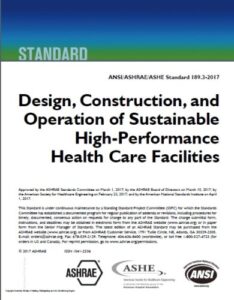ANSI/ASHRAE Standard 189.3-2017
ANSI/ASHRAE Standard 189.3-2017
ASHRAE Standard 189.3 Design, Construction, and Operation of Sustainable High-Performance Health Care Facilities was developed parallel to, yet separately from, ASHRAE/USGBC/IES Standard 189.1 to address the sustainability of health care facilities. The intent of this standard is to bridge the goal of sustainability offered in Standard 189.1 with the practical realities expressed by the health care field. Furthermore, this standard provides procedures for the integration of sustainable principles into the health care facility design, construction, and operation process including: integrated design, conservation of water, conservation of energy, indoor environmental quality (IEQ) practices, construction practices, commissioning, and operations and maintenance.
You can also read ASHRAE 55-2017 Thermal Environmental Conditions for Human Occupancy
ANSI/ASHRAE Standard 189.3-2017 content
- SECTION PAGE
![ASHRAE Standard 189.3-2017]()
- Foreword
- Purpose
- Scope
- Definitions, Abbreviations, and Acronyms
- Administration and Enforcement
- Site Sustainability
- Water Use Efficiency
- Energy Efficiency
- Indoor Environmental Quality (IEQ)
- The Building’s Impact on Materials and Resources
- Construction and Plans for Operation
- Emissions, Effluent, and Pollution Control
- I: Informative References
- J: Materials and Resources
- K: Emissions, Effluents, and Pollution Control
Health care facilities represent one of the largest and most intensive energy consumers in many communities. Thus, they often have a substantial interest in sustainable development and may aim to serve as successful models of sound environmental and fiscal stewardship by employing energy conservation strategies that reduce operating costs. However, there are limitations on the ability of health care facilities to provide the necessary capital for the increasingly complex new facilities needed to meet sustainability objectives.
Health care facilities have a substantial interest in sustainable development. These facilities are often the largest and most energy intensive buildings in a community, and their leadership recognizes that opportunities to conserve energy and reduce operating costs are matters of sound environmental and fiscal stewardship.


Comments are closed.